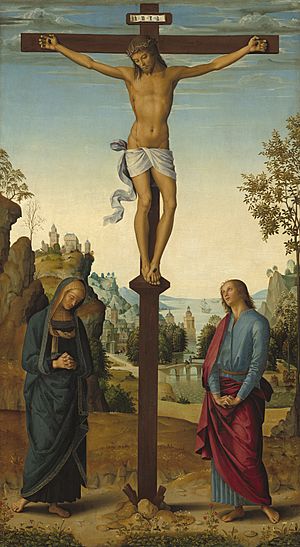Stabat Mater facts for kids
The Stabat Mater is a 13th-century Christian hymn to Mary, which portrays her suffering as Jesus Christ's mother during his crucifixion. Its author may be either the Franciscan friar Jacopone da Todi or Pope Innocent III. The title comes from its first line, "Stabat Mater dolorosa", which means "the sorrowful mother was standing".
The hymn is sung at the liturgy on the memorial of Our Lady of Sorrows. The Stabat Mater has been set to music by many Western composers.
Contents
Date
The Stabat Mater has often been ascribed to Jacopone da Todi, OFM (ca. 1230–1306), but this has been strongly challenged by the discovery of the earliest notated copy of the Stabat Mater in a 13th-century gradual belonging to the Dominican nuns in Bologna (Museo Civico Medievale MS 518, fo. 200v-04r).
The Stabat Mater was well known by the end of the 14th century and Georgius Stella wrote of its use in 1388, while other historians note its use later in the same century. In Provence, about 1399, it was used during the nine days' processions.
As a liturgical sequence, the Stabat Mater was suppressed, along with hundreds of other sequences, by the Council of Trent, but restored to the missal by Pope Benedict XIII in 1727 for the Feast of the Seven Dolours of the Blessed Virgin Mary.
Text and translation
The Latin text below is from an 1853 Roman Breviary and is one of multiple extant versions of the poem. The first English translation by Edward Caswall is not literal but preserves the trochaic tetrameter rhyme scheme and sense of the original text. The second English version is a more formal equivalence translation.
|
1. Stabat mater dolorósa |
At the Cross her station keeping, – Translation by Edward Caswall |
The sorrowful mother was standing |
Musical settings
Composers who have written settings of the Stabat Mater include:
- Josquin des Prez
- Orlande de Lassus (1585)
- Palestrina: Stabat Mater (c.1590)
- Giovanni Felice Sances (1643)
- Marc-Antoine Charpentier H.15 & H.387 (1685–90)
- Louis-Nicolas Clérambault C. 70 (17..)
- Sébastien de Brossard SdB.8 (1702)
- Emanuele d'Astorga (1707)
- Vivaldi: Stabat Mater (1712)
- Domenico Scarlatti (1715)
- Nicola Fago (1719)
- Scarlatti: Stabat Mater (1723)
- Antonio Caldara (~1725)
- Agostino Steffani (1727)
- Pergolesi: Stabat Mater (1736)
- Nicola Logroscino (1760)
- Florian Leopold Gassmann (~1765)
- Haydn: Stabat Mater (1767)
- Giuseppe Tartini (1769)
- Tommaso Traetta (1770)
- Antonio Soler (1775)
- Boccherini: Stabat Mater (1781, 1801)
- Franz Ignaz Beck (1782)
- Pasquale Cafaro (1784)
- Schubert: Stabat Mater in G minor (1815) and Stabat Mater in F minor (1816)
- Rossini: Stabat Mater (1831–1841)
- Peter Cornelius (1849)
- Liszt: part of the oratorio Christus (1862–1866)
- Dvořák: Stabat Mater (1876–1877)
- Laura Netzel (1890)
- Josef Bohuslav Foerster: Op. 56 (1891–1892)
- František Musil: Op. 50 (1893)
- Giuseppe Verdi (1897)
- Charles Villiers Stanford (1906)
- Toivo Kuula (1919)
- George Oldroyd (1922)
- Szymanowski: Stabat Mater (1925–1926)
- Johann Nepomuk David (1927)
- Lennox Berkeley (1947)
- Julia Perry (1947)
- Poulenc: Stabat Mater (1950)
- Penderecki: in St Luke Passion (1963–1966)
- Pärt: Stabat Mater (1985)
- Knut Nystedt (1986)
- Amaral Vieira (1988)
- Trond Kverno (1991)
- Pawel Lukaszewski (1994)
- Vladimir Martynov (1994)
- Salvador Brotons (1997)
- Frank Ferko (1999)
- Vladimír Godár (2001)
- Bruno Coulais (2005)
- Karl Jenkins: Stabat Mater (2008)
- Paul Mealor (2009, revised 2010)
- Metropolitan Hilarion (2011)
- Franco Simone (2014)
- James MacMillan (2015)
- Vache Sharafyan
Most settings are in Latin. Karol Szymanowski's setting is in Polish, although it may also be sung in Latin. George Oldroyd's setting is in Latin with an English translation for Anglican and Episcopalian use.
See also
 In Spanish: Stabat Mater para niños
In Spanish: Stabat Mater para niños
- Catholic Mariology


